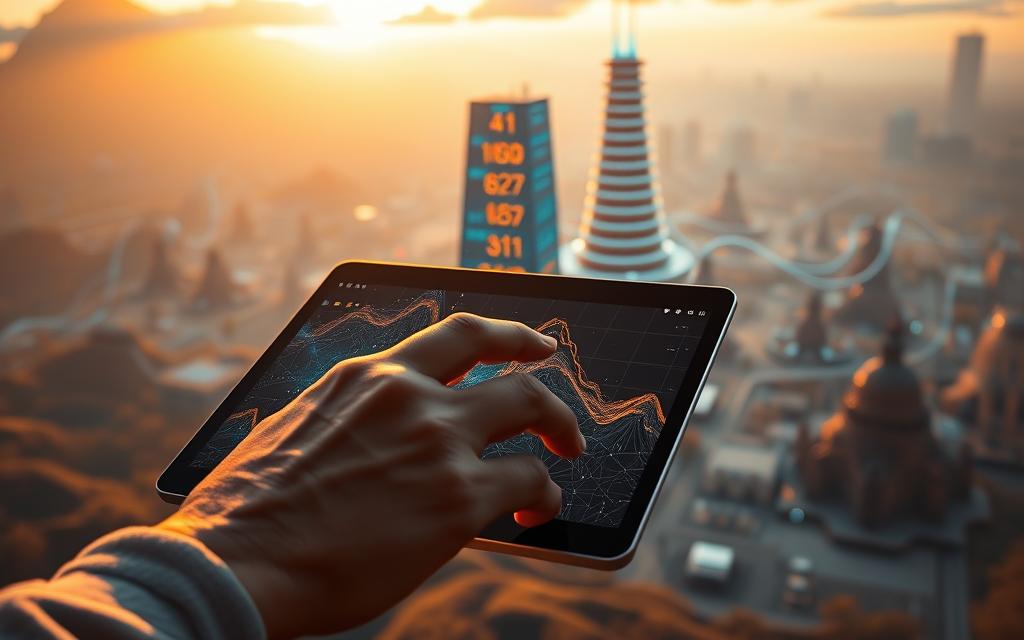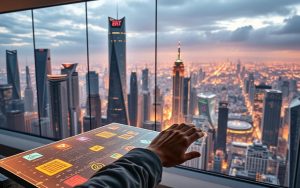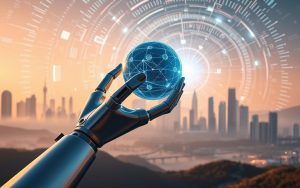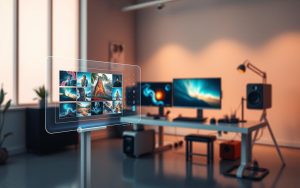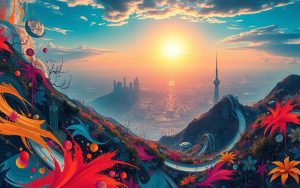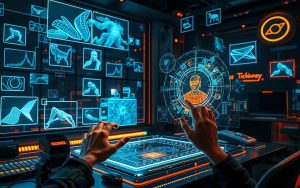Table of Contents
The advent of AI technology has revolutionized the field of photography, transforming the way we create and perceive images. With the emergence of AI image generators, the boundaries of visual art and creation have been pushed beyond traditional limits.
These innovative tools enable both professionals and amateurs to produce stunning, photorealistic images with unprecedented ease and efficiency. The core technology behind these generators differs significantly from traditional photo editing software, offering a new dimension in digital art creation.
The concept of photorealism in AI-generated imagery represents a significant advancement, offering creation possibilities that were previously unimaginable. As AI photo generators continue to evolve, they are becoming increasingly popular across various industries and creative fields.
The Evolution of AI in Photography
AI’s impact on photography is transforming traditional methods into innovative, technology-driven processes. This transformation is evident in the way AI photo generators are changing the landscape of image creation.
From Traditional Photography to AI-Enhanced Imagery
Traditional photography relied heavily on manual skills and equipment. With the advent of AI, photographers can now enhance their images using sophisticated algorithms that adjust lighting, texture, and composition. AI image generation has become a powerful tool, allowing for the creation of images that were previously impossible to capture.
How AI Photo Technology Works
AI photo technology works by analyzing vast datasets of images to learn patterns and visual elements. This knowledge is then used to generate new images based on text prompts. The process involves complex algorithms, including neural networks and Generative Adversarial Networks (GANs), to produce high-quality images.
| Technology | Description | Application |
|---|---|---|
| Neural Networks | Complex algorithms that learn from data | Image Generation |
| GANs | Generative models that create new data | Realistic Image Synthesis |
| Machine Learning | Enables systems to improve from experience | Image Enhancement |
The AI photo generator technology is continuously evolving, providing more sophisticated tools for photographers and artists. As the technology advances, we can expect to see even more realistic and creative image generation capabilities.
Understanding AI Photo Generators
The development of AI photo generators has marked a significant milestone in the evolution of photography, allowing for unprecedented levels of image manipulation and creation. These tools utilize sophisticated algorithms to analyze vast databases of images, thereby understanding and replicating real-world visual elements with remarkable accuracy.
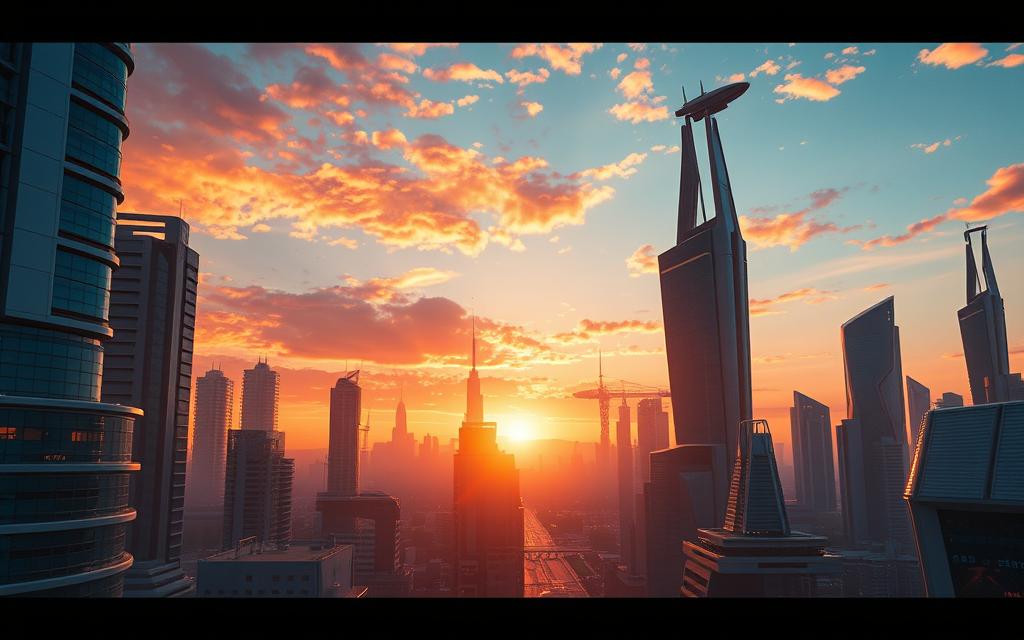
Key Features of Modern AI Image Generation Tools
Modern AI image generation tools boast several key features that enable the creation of highly realistic images. These include the ability to understand and replicate complex visual elements such as human faces, natural environments, and architectural details. Advanced AI architectures like diffusion models excel at creating photorealistic imagery by learning from vast datasets.
- Deep dive into specific AI architectures that excel at creating photorealistic imagery.
- Analysis of how AI models handle complex visual elements.
- Exploration of how AI systems blend multiple reference images to create new compositions.
The Technology Behind Photorealistic AI Images
The technology behind photorealistic AI images involves sophisticated algorithms that analyze vast image databases to understand and replicate real-world visual elements. This includes learning to replicate real-world physics like lighting, shadows, reflections, and textures. The quality and style of photorealistic outputs are significantly determined by the training data used.
- Explanation of how AI systems learn to understand and replicate real-world physics.
- Discussion of the computational challenges in generating high-resolution photorealistic images.
- Overview of recent breakthroughs that have improved the photorealism of AI-generated images.
Creating Stunning Images with AI Photo Generators
AI photo generators have revolutionized the way we create images, offering unprecedented control over styles, colors, and composition. Whether you’re aiming for minimalistic elegance or rich, detailed visuals, guide the generative AI by specifying these preferences in your description.
Crafting Effective Prompts for Best Results
Crafting effective prompts is crucial for achieving the desired outcome with AI photo generators. Consider composition elements like background blur, angle, and depth of field to guide the AI. Different artistic styles, such as photorealistic, digital art, or watercolor, can significantly affect the mood and impact of the generated image.
- Specify the desired colors and styles to convey specific emotions or align with brand guidelines.
- Incorporate compositional principles like the rule of thirds, leading lines, and focal points into your prompts.
- Use techniques like visual hierarchy to direct viewer attention within the AI-generated image.
Selecting Styles, Colors, and Compositions
Selecting the right styles, colors, and composition is vital for creating visually appealing images. For instance, choosing appropriate color palettes can convey specific emotions or align with brand guidelines. Additionally, understanding compositional principles can help in creating a visual hierarchy that directs the viewer’s attention effectively.
To achieve specific lighting effects, such as golden hour or dramatic shadows, through prompt engineering, it’s essential to be precise in your descriptions. The selection of the background and depth of field also plays a crucial role in the overall impact of the generated image.
Advanced Techniques for AI-Generated Photography
The art of AI-generated photography involves not just generating images, but crafting them with precision and creativity. As AI photo generation tools become more sophisticated, understanding advanced techniques is crucial for producing high-quality, professional results.
Mastering Composition and Visual Elements
Mastering composition and visual elements is essential for creating compelling AI-generated images. This involves understanding how to effectively use prompts that guide the AI tool to produce desired outcomes. By refining your prompts, you can significantly improve the quality of the generated image.
To achieve this, consider the following strategies:
- Experiment with different styles and themes to find what works best for your project.
- Use specific keywords related to the composition and visual elements you want to emphasize.
- Adjust parameters such as color palette, lighting, and texture to enhance the image.
For instance, a well-crafted prompt might result in an image that requires minimal post-processing. The table below illustrates how different prompt strategies can impact the final image:
| Prompt Strategy | Resulting Image Quality | Post-processing Needs |
|---|---|---|
| Basic Prompt | Low | High |
| Detailed Prompt | High | Low |
| Advanced Prompt with Specifics | Very High | Minimal |
Refining and Experimenting with AI Outputs
Refining and experimenting with AI outputs is a critical step in the image creation process. By analyzing the initial results and adjusting your prompts accordingly, you can iteratively improve the quality of the generated images.
Some effective methods include:
- Combining multiple AI-generated elements to create complex composite images.
- Using external editing software to add finishing touches to the AI-generated images.
- Experimenting with different prompt variations to achieve unexpected yet inspiring results.
By adopting these advanced techniques, you can significantly enhance the quality and creativity of your AI-generated photography, pushing the boundaries of what is possible with this innovative technology.
Practical Applications of AI Photo Generation
AI is making a significant impact on how images are created and used across different sectors. This technology is not only enhancing existing processes but also opening up new avenues for creativity and innovation.
Marketing and Social Media Content Creation
In the realm of marketing and social media, AI photo generation is proving to be a game-changer. It enables businesses to create images quickly and efficiently, reducing the time and cost associated with traditional photo shoots. AI tools can generate high-quality visuals tailored to specific marketing campaigns, enhancing engagement and brand recognition.
For instance, AI can be used to create personalized content for social media platforms, allowing companies to connect with their audience on a more individual level. This personalized approach can lead to increased customer loyalty and brand advocacy.
| Application | Benefit |
|---|---|
| Personalized Social Media Content | Increased Customer Engagement |
| Quick Content Generation | Reduced Production Time and Cost |
Design, Art, and Creative Projects
In the fields of design and art, AI photo generation is being used to explore new creative directions and visualize concepts quickly. Artists and designers can leverage AI as a tool for inspiration, generating starting points for projects that might otherwise be challenging to begin.
AI-generated images can also be used to create unique hybrid works that blend human creativity with AI-generated elements. This fusion can lead to innovative art and design pieces that push the boundaries of traditional creative fields.
By embracing AI photo generation, professionals in these fields can overcome creative blocks, explore new ideas, and develop cohesive visual styles across multiple projects.
The Future of Photography in an AI-Driven World
As AI continues to evolve, the photography landscape is poised for a revolutionary transformation. The emerging trends in AI photo generation technology are not only enhancing image creation but also raising important questions about the future of photography. One of the key areas of concern is the ethical implications of increasingly photorealistic AI-generated imagery, including issues of authenticity and misinformation.
The relationship between human photographers and AI tools is likely to evolve into a collaborative partnership rather than a replacement. AI will influence photographic styles, aesthetics, and creative approaches, opening up new possibilities for artists and photographers. New career paths and specializations are emerging at the intersection of photography and AI, offering exciting opportunities for professionals in the field.
To thrive in this new landscape, photographers must be prepared to adapt and evolve. Exploring resources like utilizing AI tools for photo editing can provide valuable insights into the potential of AI in photography. As AI-generated imagery becomes more prevalent, it will be crucial to address the challenges it poses, including adapting copyright law and creative ownership to accommodate AI-generated content.
The future of photography in an AI-driven world is complex and multifaceted, raising fundamental questions about creativity, authorship, and artistic expression. As we move forward, it is essential to navigate these changes thoughtfully, embracing the potential of AI while preserving the essence of photographic art.
FAQ
What is the primary function of an image generation tool?
The primary function is to create high-quality, photorealistic images based on user input, such as text prompts, styles, and colors.
How do I achieve the best results with an image generator?
To achieve the best results, craft effective prompts, select suitable styles, colors, and compositions, and refine your outputs through experimentation.
Can I use AI-generated images for commercial purposes, such as marketing and social media content creation?
Yes, AI-generated images can be used for various commercial purposes, including marketing, social media content creation, design, art, and creative projects.
How do AI image generation tools work?
These tools utilize complex algorithms and machine learning models to generate images based on user input, leveraging large datasets and advanced technology.
What are the key features of modern image generation tools?
Key features include the ability to generate high-quality images, support for various styles and colors, and the capacity to refine outputs through user input and iteration.
Can I customize the style and composition of AI-generated images?
Yes, users can select from a wide range of styles, colors, and compositions to create unique and tailored images that meet their specific needs.


